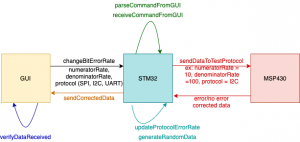What did you personally accomplish this week on the project? Give files or photos that demonstrate your progress. Prove to the reader that you put sufficient effort into the project over the course of the week (12+ hours).
At the beginning of this week, my team and I were putting the final touches on our design presentation; I was last-minute finding the best ways to measure latencies on the STM 32 and making sure that the GUI + interactions diagrams were finished and looked good. When I was looking into how to best measure latencies, I found that we can use oscilloscope via an unused pin, hardware timers: Hal_tick/sys_tick, TIMx, or analyze assembly code + count clock cycles. Finding multiple ways to measure the latency provides flexibility with our verification so that we aren’t dependent on one method if another method falls through. Additionally, it allows us to verify that the latency measured is correct by being able to verify through multiple ways.
Once the presentation was done, we realized that the GUI + the interactions between the components were good and more focused needed to be put towards the actual implementation of the protocols. Therefore, I took over the stream of bits (GPIO + SPI) protocols since my teammate will focus his efforts on the serial data transmission (I2C + UART). I felt that my work on the GUI was mostly done and I wanted to help off load some of the work from them.
Regarding the protocols for streams of bits, I determined what the constraints should be for stream of bits by finding implementations of convolutional codes with the Viterbi algorithm online that is most similar to what our implementation would be. With testing of various code rates and constraint configurations for passing 113 bits, the average latency was 0.004 seconds, which will be our goal latency; 113 bits = 13 bytes is the amount of bits that CubeRover is currently expecting to pass through SPI and GPIO. Additionally, we determined how the code rate will be determined; after researching the best code rates for convolutional codes, I realized that it will ultimately vary and it will be best to try out a handful of code rates (1/2, 4/7, 6/7 etc) to determine which one is best. Like the code rates, the constraint will be determined by testing various values to determine which one the lowest latency. Moreover, my research solidified choosing the Viterbi algorithm + convolutional codes since Turbo Coding and LPDC are best for streams with a high throughput and since CubeRover is not expecting a high throughput, using convolutional codes is the best fit.
Is your progress on schedule or behind? If you are behind, what actions will be taken to catch up to the project schedule?
I believe that my progress is behind schedule; ideally, I would have liked to begun coding already but because we forgot to order a cable, I can’t upload any code to the STM32 yet. Despite having the GUI and software + hardware interactions figured out, I feel that we are behind with a lot of the specifications for the protocols which was also communicated to us through the presentation feedback. Additionally, because we kept deciding between a decentralized model vs a centralized model, those discussions hindered our work and took up time that we could have spent working on other components.
What deliverables do you hope to complete in the next week?
The design document is due Monday night, so that will be for sure completed with the correct specifications listed as that was the biggest critique of our feedback from the presentation. I would like to begin either working on the GUI or convolutional codes with Viterbi; I am meeting with my teammates tomorrow discuss what components should be prioritized to work on.
Minimum Goals For This Week
– Draft of Convolutional Code + Viterbi Algorithm
– Create Functions that can read/write data bytes to STM32 from GUI


